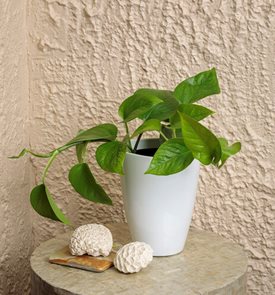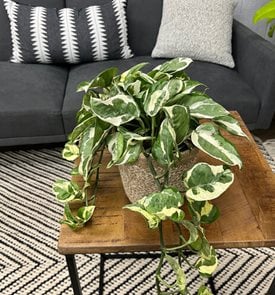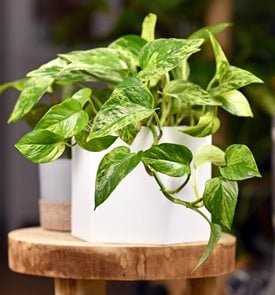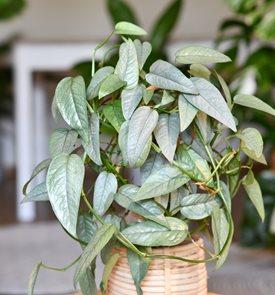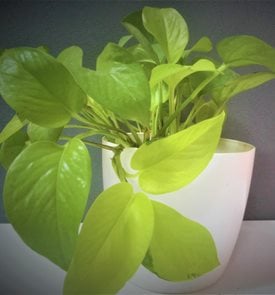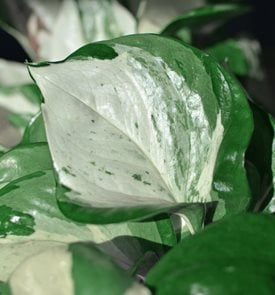POTHOS PLANTS: ESSENTIAL CARE & GROWING GUIDE
The lush foliage of this carefree houseplant adds instant beauty to your home or office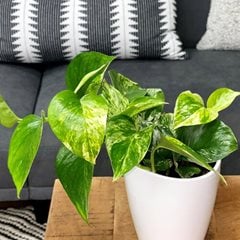
Beautifall® Marble Queen pothos. Photo by: Proven Winners
One of the easiest indoor plants to grow, pothos (Epipremnum aureum) is often overlooked in favor of showier plants such as orchids. Though lacking blooms, this tropical vine—similar to philodendron—comes in an array of foliage colors and patterns that appeal to a wide range of tastes and decors. Nearly foolproof even for beginners, pothos is forgiving of neglect, virtually pest- and disease-free, and is a great low-light indoor plant perfect for darker rooms and offices.
The long stems trail or climb by aerial roots that adhere to surfaces, making this a versatile choice for hanging baskets, plant stands, and bookshelves. Best of all, pothos is one of the top houseplants for improving indoor air quality, making home and office environments cleaner.
On this page: Basics | Growing Tips | Care | Pothos Pictures | Toubleshooting | Display Ideas
POTHOS BASICS
Botanical name:
Epipremnum aureum
Common names:
Devil’s vine, Ceylon creeper, taro vine, ivy arum, silver vine, and Solomon Islands ivy.
Origin:
Native to tropical regions of Southeast Asia and Western Pacific islands.
Zones:
USDA Zones 10-12. Plants can be grown outdoors in frost-free regions of Florida and California.
Care level:
Easy.
Light requirements:
Bright indirect light is ideal, but plants are tolerant of low light and fluorescent lighting. Avoid direct sunlight, which can burn or discolor foliage.
Growth rate:
Slow to fast depending on variety. More variegation in the leaves tends to slow growth.
Foliage:
Shiny leaves are 4-12 inches long, heart- or lance-shaped, in colors of green, chartreuse, blue, or variegated patterns.
Flowers:
Small, white, hooded flowers are insignificant, occurring on mature plants in their native habitat. Plants will not flower in the average home environment.
Habit and size:
Vining, trailing habit, 6-10 feet long; can grow as long as 30-50 feet in their native habitat.
Toxicity:
All parts of the plant are mildly to moderately poisonous if ingested by pets or children. See more Common Poisonous Plants for Dogs and Cats.
Pothos lookalikes:
The leaves can look nearly identical to heart-leaf philodendron. Pothos has thicker, more textural leaves, while those of philodendron tend to be darker, smoother, and less likely to be variegated. The leaf stem of pothos has a slight groove, while those of philodendron are smooth. Philodendron foliage is distinctly heart shaped, while pothos leaves can be asymmetrical. They both have similar growing conditions and care requirements.
Pothos is also related to common garden plants such as anthurium, caladium, and calla lily.
POTHOS GROWING TIPS
Where to grow:
Site near a window that receives bright indirect light and avoid cold drafts.
Temperature and humidity:
Plants should be kept at temperatures above 50 degrees F, with ideal temperature range between 60-80 degrees F. Pothos prefers high humidity similar to its native habitat, but is tolerant of average or dry air. Plants will benefit from supplemental air moisture such as misting or a room humidifier during winter when indoor air is drier.
Soil type:
Grow in a high quality, well-draining potting mix. Pothos prefers a slightly acidic pH of 6.1 to 6.5, but is tolerant of values slightly above or below.
Pot requirements:
Plant in a container 1-2 inches wider than the root ball with adequate drainage holes.
Propagation:
Pothos is easily propagated through stem cuttings. Cut stems 6 inches long just below a leaf node and place in water. Roots will develop over a month or two. Change water every 2-3 weeks. Plant well-rooted cuttings in fresh potting soil. Grow multiple stems in the same pot for the lushest growth.
Plants can also be propagated through division. Gently cut the root ball into sections and repot in fresh soil, leaving 1-2 inches of space around the root ball.
POTHOS CARE
Watering:
Allow the top inch of soil to dry out between waterings; overwatering can cause root rot. Discard excess water from the saucer underneath the pot so that plants are not sitting in water.
Fertilizing:
Pothos are light feeders. Apply a balanced liquid houseplant fertilizer every 1-3 months to keep plants looking healthy.
Pruning:
Plants can be kept more compact or allowed to sprawl. Trim back long runners to keep plants full and bushy. Bare stems can be cut back to soil level to encourage new branches to sprout. For a vining habit, allow plants to grow naturally.
Cleaning:
Wipe leaves with a damp cloth every few weeks to keep foliage looking fresh.
Repotting:
If plants become droopy no matter how much they’re watered, this can be a sign of being rootbound. Remove the plant from its container; if roots appear crowded and are circling tightly, then it’s time to repot. Place in a new container 1-2 inches wider in fresh potting soil.
POTHOS VARIETIES
See more Beautifall® pothos plants from the leafjoy® line from Proven Winners.
TROUBLESHOOTING
Pothos have few insect or disease problems. Here are some things to look for:
- Brown or yellow leaves: If older leaves are brown or yellow while new growth looks fine, this can be an indication of underwatering. Trim back affected stems to the base of the plant to encourage new growth and increase watering.
- Loss of foliage color: Fading color is likely due to low light. Move to a brighter location.
- Pale or brown leaves: This may be a sign that plants are getting too much light. Move to a location with less light.
- Blackened leaves or stems or sudden plant collapse: Possibly a sign of overwatering and root rot. Cut off affected branches. Allow soil to completely dry out and new roots to develop. In severe cases, plants may not recover.
- Shriveled, yellow, wilted or brown edges on leaves: This can be a sign of underwatering. Increase watering as needed.
- Blackened leaves and little or no growth: Can be a result of cold temperatures. Move plants to a warmer location and trim off affected growth. The roots should be fine and push out new growth.
- Pests: Can include mealybugs or scale. Wipe affected areas with a swab or cotton ball dipped in 70% rubbing alcohol, or apply insecticidal soap. If soil stays too wet over a period of time, it may attract fungus gnats. Allow soil to dry out between waterings to deter gnats. (See more on common houseplant pests.)
DISPLAY IDEAS
- Pothos can be kept compact and bushy, or allowed to develop a trailing habit. How best to display your pothos depends on how it is trained.
- Grow a trailing plant in a hanging basket and allow the foliage to cascade for an elegant display. Place in a bedroom, living room or office to enjoy the benefits of air purification. (See more indoor hanging plants)
- Train a vining form up a vertical support such as driftwood, bark, a decorative trellis or pole for a natural rain forest effect.
- Allow a vining form to sprawl horizontally along a table top, mantelpiece or bookshelf for a softening, living touch.
- Long runners can be trained along a wall or window frame, the branches secured with small cup hooks. This can give the appearance of integrating the indoors with nature.
- Feature a bushy type in a decorative pot as a living accent on a coffee table, end table, office desk or plant stand. Use a slower growing variegated form to reduce the need for pruning.
- Place a trailing or bushy form on a shelf or hanger in a bathroom where it will thrive on the increased humidity and warmth from showers and baths.
- Display a green or slightly variegated form that needs less light on your office desk to lift your mood during the work day.
- Plant a green variety that tolerates low light in a brightly colored decorative pot. Place in a dull, drab corner of the house to liven up the space.

